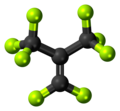Perfluoroisobutene
| |||
| Names | |||
|---|---|---|---|
| Preferred IUPAC name
1,1,3,3,3-Pentafluoro-2-(trifluoromethyl)prop-1-ene | |||
| Other names
Perfluoroisobutene, Perfluoroisobutylene, Octafluoroisobutylene, Octafluoro-sec-butene, PFIB
| |||
| Identifiers | |||
3D model (JSmol)
|
|||
| ChEMBL | |||
| ChemSpider | |||
| ECHA InfoCard | 100.108.743 | ||
| EC Number |
| ||
PubChem CID
|
|||
| RTECS number |
| ||
| UNII | |||
CompTox Dashboard (EPA)
|
|||
| |||
| |||
| Properties | |||
| C4F8 | |||
| Molar mass | 200.030 g/mol | ||
| Appearance | colorless gas | ||
| Density | 8.2 g/l | ||
| Melting point | −130 °C (−202 °F; 143 K) | ||
| Boiling point | 7.0 °C (44.6 °F; 280.1 K) | ||
| Hazards | |||
| GHS labelling: | |||
 
| |||
| Danger | |||
| H330, H370 | |||
| P260, P264, P270, P271, P284, P304+P340, P307+P311, P310, P320, P321, P403+P233, P405, P501 | |||
Except where otherwise noted, data are given for materials in their standard state (at 25 °C [77 °F], 100 kPa).
| |||
Perfluoroisobutene (PFIB) is the perfluorocarbon with the formula (CF3)2C=CF2. Classified as a perfluoroalkene, it is the fluorinated counterpart of the hydrocarbon isobutene. This colorless gas is notable for its high toxicity.[1]
Production and reactions
[edit]PFIB is one product of pyrolysis of polytetrafluoroethylene (PTFE).[2] Tetrafluoroethylene thermally dimerizes to octafluorocyclobutane, which above 600 °C degrades to hexafluoropropylene and PFIB.[1]
Perfluoroisobutene is highly reactive toward nucleophiles, e.g. methanol.[1] It alsoforms addition compounds with thiols, and it is this reactivity that may be related to its toxicity.[3] It hydrolyzes readily to give the relatively innocuous (CF3)2CHCO2H, which readily decarboxylates to give hexafluoropropane.[citation needed]
Oxidation of HFIB with potassium permanganate gives hexafluoroacetone.[4]
Safety
[edit]Perfluoroisobutene is highly toxic with an LCt = 880 mg⋅min⋅m−3 (mice).[3] It is a Schedule 2 substance of the Chemical Weapons Convention. Its toxicity is comparable to that of phosgene.[1]
References
[edit]- ^ a b c d Siegemund, Günter; Schwertfeger, Werner; Feiring, Andrew; Smart, Bruce; Behr, Fred; Vogel, Herward; McKusick, Blaine (2000). "Fluorine Compounds, Organic". Ullmann's Encyclopedia of Industrial Chemistry. doi:10.1002/14356007.a11_349. ISBN 978-3-527-30385-4.
- ^ Stewart, Charles E. (2006). Weapons of mass casualties and terrorism response handbook. American Academy of Orthopaedic Surgeons. Sudbury, Mass: Jones and Bartlett. ISBN 978-0-7637-2425-2.
- ^ a b Timperley, Christopher M. (2000). "Highly-toxic fluorine compounds". Fluorine Chemistry at the Millennium. pp. 499–538. doi:10.1016/B978-008043405-6/50040-2. ISBN 9780080434056.
- ^ Michael Van Der Puy, Louis G. Anello (1985). "Hexafluoroacetone". Organic Syntheses. 63: 154. doi:10.15227/orgsyn.063.0154.


